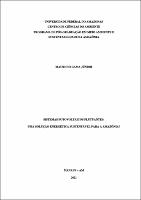| ???jsp.display-item.social.title??? |


|
Please use this identifier to cite or link to this item:
https://tede.ufam.edu.br/handle/tede/9012| ???metadata.dc.type???: | Dissertação |
| Title: | Sistemas fotovoltaicos flutuantes: uma solução energética sustentável para a Amazônia? |
| Other Titles: | Floating photovoltaic systems: a sustainable energy solution for Amazon? |
| ???metadata.dc.creator???: | Gama Júnior, Mauricio  |
| ???metadata.dc.contributor.advisor1???: | Waichman, Andrea Viviana |
| First advisor-co: | Tezza Neto, João |
| ???metadata.dc.contributor.referee1???: | Silva, Neliton Marques da |
| ???metadata.dc.contributor.referee2???: | Souza, Rubens Cesar Rodrigues |
| ???metadata.dc.contributor.referee3???: | Tezza Neto, João Batista |
| ???metadata.dc.description.resumo???: | A geração hidrelétrica permanece como a principal fonte de geração de eletricidade no Brasil, mantendo a Matriz Elétrica brasileira predominantemente abastecida por fontes renováveis. Apesar disso, a geração hidrelétrica brasileira é sensível aos ciclos hidrológicos dos cursos d’água, podendo ser severamente impactadas por mudanças climáticas nos próximos anos, interferindo negativamente na segurança energética nacional, além de ser uma fonte com altos impactos ambientais, inclusive a emissão de gases do efeito estufa. Como o potencial hidrelétrico inexplorado dos rios próximos aos grandes centros consumidores está se esgotando, e grande parte do potencial inexplorado se encontra na Amazônia, a construção de hidrelétricas na nessa região é tema recorrente no setor energético nacional, a despeito dos impactos e dificuldades relacionados a este tipo de projeto, dos quais a Usina Hidrelétrica de Balbina é exemplo categórico. O presente estudo analisa a utilização de sistemas fotovoltaicos flutuantes (FVF) sobre reservatórios de grandes usinas hidrelétricas na Amazônia. Sistemas fotovoltaicos flutuantes são grandes arranjos fotovoltaicos instalados sobre corpos d’água, com os módulos fotovoltaicos posicionados sobre flutuadores. A geração FVF, quando instalada sobre reservatórios de hidrelétricas, pode operar autonomamente como uma usina fotovoltaica tradicional, ou operar em cooperação com a hidrelétrica potencializando as vantagens (abundância e renovabilidade) e mitigando as debilidades (sazonalidade e intermitência) de ambas as fontes. Foram realizadas estimativas e modelos de instalação e aproveitamento, e em seguida foram analisadas as fontes em termos de sustentabilidade ambiental, estimando os resultados em termos energéticos das duas fontes atuando em cooperação, e também em termos de impactos ambientais, comparando com a alternativa de construção de novas hidrelétricas na Amazônia Brasileira, verificando se o uso deste tipo de tecnologia é mais vantajosa em termos de sustentabilidade ambiental. A análise comparativa foi realizada utilizando a Matriz Rápida de Avaliação de Impactos. Verificou-se que os impactos ambientais são mais reduzidos quando a FVF opera em complementariedade com a UHE instalada na barragem, melhorando o desempenho de ambas a instalações. Barragens antigas, com grandes reservatórios, desempenho energético ruim e maiores passivos ambientais são preferíveis para a instalação deste tipo de usina na Amazônia. |
| Abstract: | Hydroelectric generation remains the main source of electricity generation in Brazil, with Brazilian Electric Matrix predominantly supplied by renewable sources. Nevertheless, brazilian hydroelectric generation is sensitive to the hydrological cycles of local rivers, impacted by climate change in the next years, negatively interfering in national energy security, moreover, it’s a source with high environmental impacts, including the emission of greenhouse gases. As the unexplored hydroelectric potential of rivers near to big cities are ending, and a large part of the unexplored potential is found in the Amazon region, the construction of hydroelectric power plants in the Amazon is a current topic on the national energy sector, despite the impacts and difficulties of this type of project, with the major example of Balbina power plant. This study aims to analyze the use of floating photovoltaic systems (FVF, in portuguese initials) about reservoirs of large hydroelectric power plants in the Amazon region. Floating photovoltaic systems are large photovoltaic devices installed on the water surface, with photovoltaic modules positioned on floateres. When installed on hydroelectric reservoirs, PVF generation operates autonomously as a traditional photovoltaic plant, or in cooperation with the hydroelectric power plant, to maximize the advantages, like abundance and renewability, and mitigating the fragilities, like the seasonality and intermittence, of both sources. Estimates and models of installation and utilities were made, and after that, sources were analyzed in terms of environmental sustainability, estimating the results in energy terms of the two sources, acting in cooperation, and also in terms of environmental impacts, comparing with the alternative construction of new hydroelectric power plants in the Brazilian Amazon, verifying if the use of this type of technology is better in environmental sustainability subjects. The comparative analysis was made using the Rapid Impact Assessment Matrix. It was found that the environmental impacts are reduced when the FVF operates in addition with the hydroelectric power plant installed in the dam, improving the performance of both installations. Old dams with large reservoirs, poor energy performance and greater environmental liabilities are preferable for installing this type of plant in the Amazon region. |
| Keywords: | Usinas hidrelétricas - Aspectos ambientais - Amazônia Impacto ambiental Energia - Consumo |
| ???metadata.dc.subject.cnpq???: | CIENCIAS AGRARIAS |
| ???metadata.dc.subject.user???: | Sistemas fotovoltaicos flutuantes Hidrelétricas Impactos ambientais Sustentabilidade |
| Language: | por |
| ???metadata.dc.publisher.country???: | Brasil |
| Publisher: | Universidade Federal do Amazonas |
| ???metadata.dc.publisher.initials???: | UFAM |
| ???metadata.dc.publisher.department???: | Centro de Ciências do Ambiente |
| ???metadata.dc.publisher.program???: | Programa de Pós-graduação em Ciências do Ambiente e Sustentabilidade na Amazônia |
| Citation: | GAMA JÚNIOR, Mauricio. Sistemas fotovoltaicos flutuantes: uma solução energética sustentável para a Amazônia? 2022. 148 f. Dissertação (Mestrado em Ciências do Ambiente e Sustentabilidade na Amazônia) - Universidade Federal do Amazonas, Manaus (AM), 2021. |
| ???metadata.dc.rights???: | Acesso Aberto |
| ???metadata.dc.rights.uri???: | http://creativecommons.org/licenses/by-nc-nd/4.0/ |
| URI: | https://tede.ufam.edu.br/handle/tede/9012 |
| Issue Date: | 9-Jul-2021 |
| Appears in Collections: | Mestrado em Ciências do Ambiente e Sustentabilidade na Amazônia |
Files in This Item:
| File | Description | Size | Format | |
|---|---|---|---|---|
| Dissertação_MauricioGamaJunior_PPGCASA.pdf | 2.52 MB | Adobe PDF |  Download/Open Preview |
This item is licensed under a Creative Commons License





